change wheel GMC ENVOY 1998 Owners Manual
[x] Cancel search | Manufacturer: GMC, Model Year: 1998, Model line: ENVOY, Model: GMC ENVOY 1998Pages: 386, PDF Size: 20.33 MB
Page 91 of 386
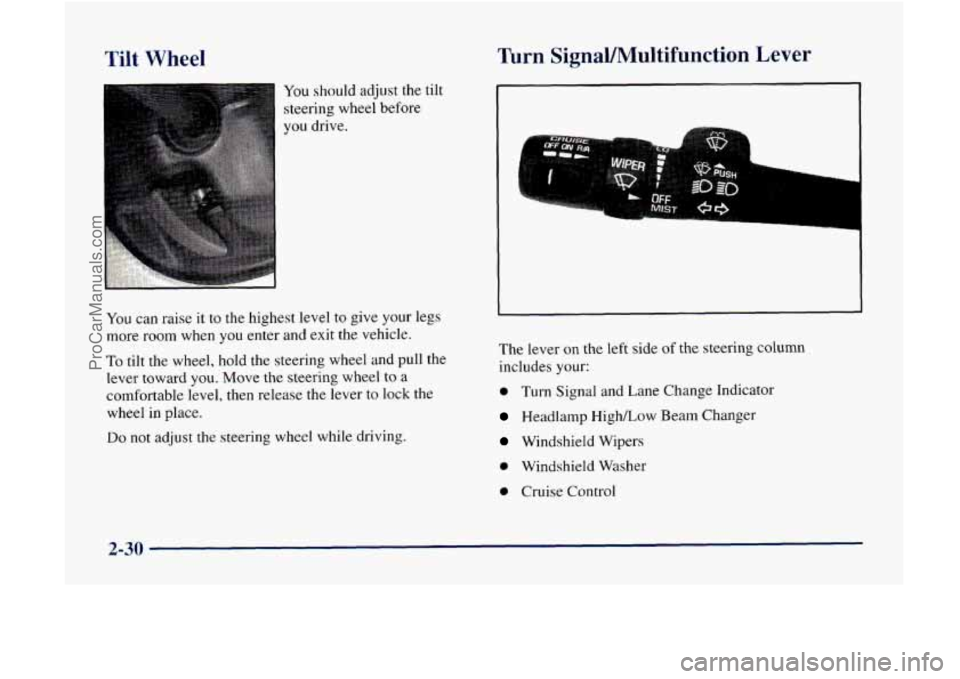
Tilt Wheel
You should adjust the tilt
steering wheel before
you drive.
Turn Signal/Multifunction Lever
You can raise it to the highest level to give your legs
more room when
you enter and exit the vehicle.
To tilt the wheel, hold the steering wheel and pull the
lever toward
YOU. Move the steering wheel to a
comfortable level, then release the lever to lock the
wheel in place.
Do not adjust the steering wheel while driving. The
lever on the left side
of the steering column
includes your:
0 Turn Signal and Lane Change Indicator
Headlamp High/Low Beam Changer
Windshield Wipers
0 Windshield Washer
0 Cruise Control
2-30
ProCarManuals.com
Page 95 of 386

CAUTION:
0
0
Cruise control can be dangerous where you
can’t drive safely
at a steady speed. So,
don’t use your cruise control on winding
roads
or in heavy traffic.
Cruise control can be dangerous on
slippery roads. On such roads, fast changes
in tire traction can cause needless wheel
spinning, and you could lose control. Don’t
use cruise control on slippery roads.
I ,A CAUTION: I
If you leave your cruise control switch on when
you’re not using cruise, you might hit a button
and go into cruise when
you don’t want to. You
could be startled and even lose control. Keep the
cruise control switch off until you want to use it.
1. Move the cruise control switch to ON.
2. Get up to the speed you want.
3. Press in the SET button
at
the end of the lever
and release it.
4. Take your foot off the accelerator pedal.
2-34
ProCarManuals.com
Page 98 of 386

Rotate the knob to the right to the master lamps symbol
to turn on all the lamps listed as well as
the headlamps.
Rotate the
knob all the way to the left to turn off your
lamps and put the system in automatic headlamp mode.
Automatic Headlamp System
When it is dark enough outside, your automatic
headlamp system will turn on your headlamps at the
normal brightness along with other lamps such as the
taillamps, sidemarker, parking lamps and the instrument
panel lights. The radio lights will also be dim.
Your vehicle is equipped with High Intensity Discharge
(€€ID) headlamps. Your headlamps come on at lower
intensity and gradually increase to full brightness.
Your vehicle is equipped with
a light sensor on the top
of the instrument panel under the radio speaker grille,
so
be sure it is not covered, which will cause the system to
be on whenever the ignition is on.
The system may also turn on your headlamps when
driving through a parking garage, heavy overcast
weather, a tunnel or fueling your vehicle in a low-light
area. This is normal.
There is a delay in the transition between the daytime
and nighttime operation of the Daytime Running Lamps
(DRL) and the automatic headlamp systems
so that driving under bridges or bright overhead street lights
does not affect the system. The DRL and automatic
headlamp system will only be affected when the light
sensor
sees a change in lighting lasting longer than
the delay.
To idle your vehicle with the automatic headlamp
system
off, set the parking brake while the ignition is
off. Then start your vehicle. The automatic headlamp
system will stay off until you release the parking brake.
As with any vehicle, you should turn on the regular
headlamp system when you need it.
Lamps On Reminder
A reminder chime will sound when your headlamps or
parking lamps
are manually turned on and your ignition
is in
OFF, LOCK or ACCESSORY. To disable the
chime, rotate the thumb wheel all the way down. In
the
automatic mode, the headlamps turn off once the
ignition key is in
OFF,
Daytime Running Lamps
Daytime Running Lamps (DRL) can make it easier for
others to see the front of your vehicle during the day.
DRL can be helpful in many different driving
conditions, but they can be especially helpful in the short periods after dawn and before sunset.
2-37
ProCarManuals.com
Page 167 of 386
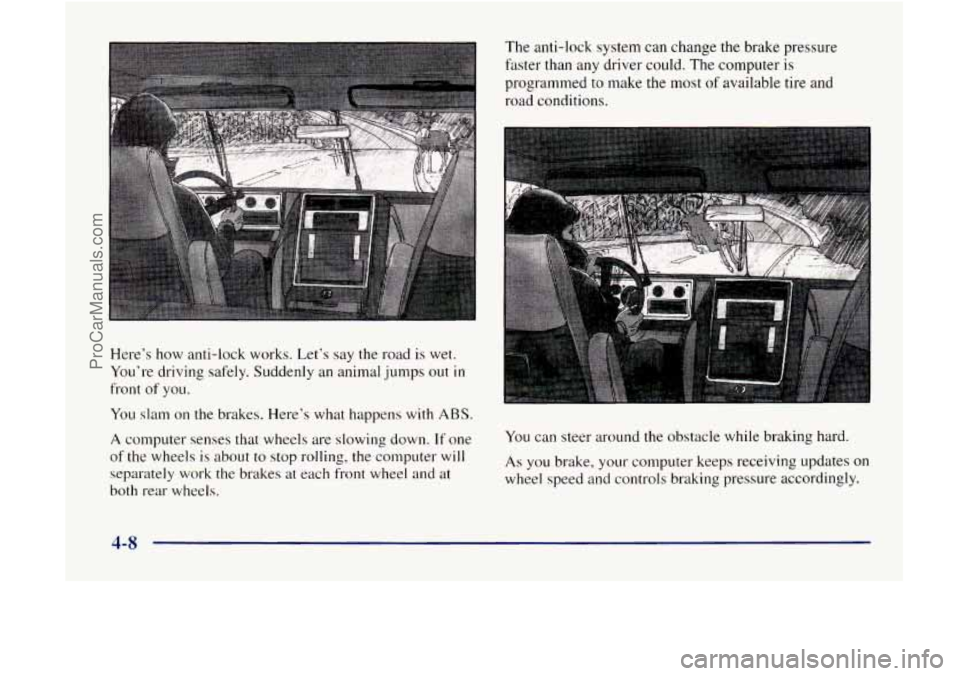
Here’s how anti-lock works. Let’s say the road is wet.
You’re driving safely. Suddenly an animal jumps out
in
front of you.
You slam on
the brakes. Here’s what happens with ABS.
A computer senses that wheels are slowing down. If one
of the wheels is about to stop rolling, the computer will
separately work the brakes at each front wheel and at
both rear wheels. The anti-lock system can
change the brake pressure
faster than any driver could. The computer
is
programmed to make the most of available tire and
road conditions.
You can steer around the obstacle while braking hard.
As you brake, your computer keeps receiving updates on
wheel speed and controls braking pressure accordingly.
4-8
ProCarManuals.com
Page 168 of 386
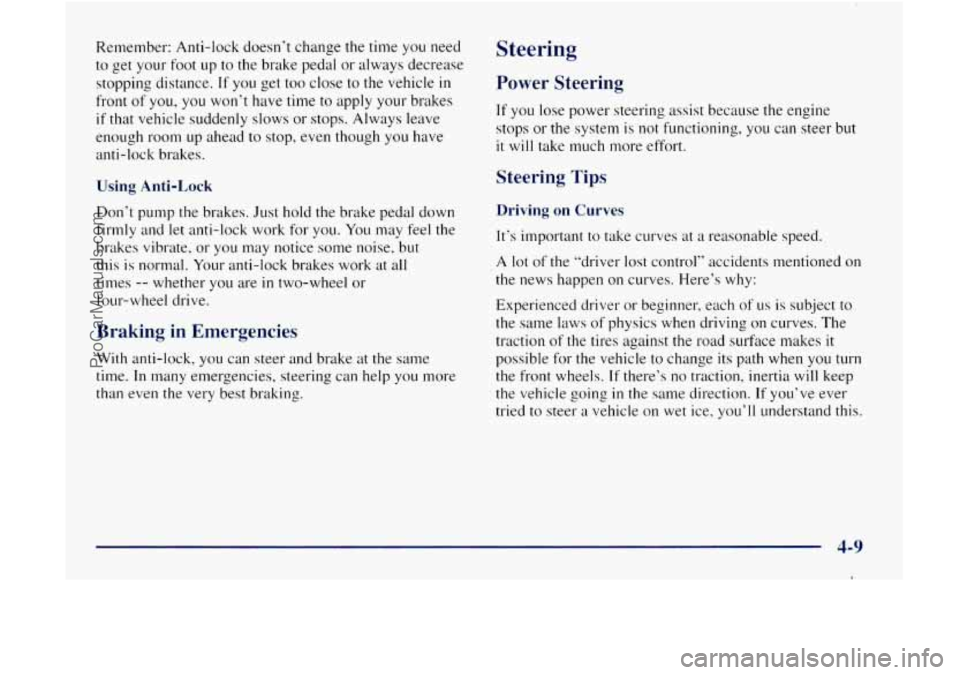
Re,member: Anti-lock doesn’t change the time you need
to get your foot up to the brake pedal or always decrease
stopping distance.
If you get too close to the vehicle in
front of you, you won’t have time to apply your brakes
if that vehicle suddenly slows or stops. Always leave
enough room up ahead
to stop, even though you have
anti-lock brakes.
Steering
Power Steering
If you lose power steering assist because the engine
stops or the system is not functioning, you can steer but
it will take much more effort.
Using Anti-Lock
Don‘t pump the brakes. Just hold the brake pedal down
firmly and let anti-lock work for you. You may feel the
brakes vibrate,
or YOLI may notice some noise, but
this is normal. Your anti-lock brakes work at all
times
-- whether you are in two-wheel or
four-wheel drive.
Braking in Emergencies
With anti-lock, you can steer and brake at the same
time.
In many emergencies, steering can help you more
than even the very best braking.
Steering Tips
Driving on Curves
It’s important to take curves at a reasonable speed.
A lot of the “driver lost control“ accidents mentioned on
the news happen on curves. Here’s
why:
Experienced driver or beginner, each of us is subject to
the same laws of physics when driving on curves. The
traction of the tires against the road surface makes
it
possible for the vehicle to change its path when you turn
the front wheels. If there’s no traction, inertia will keep
the vehicle going
in the same direction. If you’ve ever
tried to steer a vehicle on wet ice, you’ll understand this.
4-9
1
ProCarManuals.com
Page 172 of 386
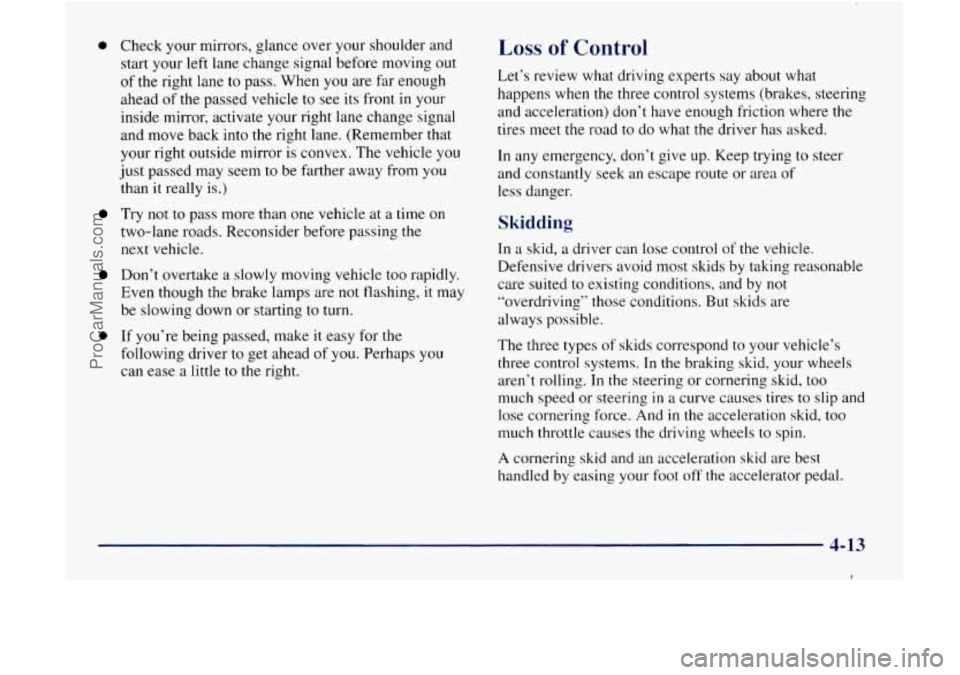
0 Check your mirrors, glance over your shoulder and
start your left lane change signal before moving out
of the right lane to pass. When you are far enough
ahead of the passed vehicle to see its front
in your
inside mirror, activate your right lane change signal
and move back into the right lane. (Remember that
your right outside mirror is convex. The vehicle you
just passed may seem to be farther away from you
than
it really is.)
Try not to pass more than one vehicle at a time on
two-lane roads. Reconsider before passing the
next vehicle.
Don’t overtake a slowly moving vehicle too rapidly.
Even though the brake lamps are not flashing, it may
be slowing down or starting to turn.
0 If you’re being passed, make it easy for the
following driver to get ahead of you. Perhaps
you
can ease a little to the right.
Loss of Control
Let’s review what driving experts say about what
happens
when the three control systems (brakes, steering
and acceleration) don’t have enough friction where the
tires meet the road
to do what the driver has asked.
In any emergency, don’t give up. Keep trying
to steer
and constantly seek an escape route or area of
less danger.
Skidding
In a skid, a driver can lose control of the vehicle.
Defensive drivers avoid most skids by taking reasonable
care suited to existing conditions, and by not
“overdriving” those conditions. But skids are
always possible.
The three types
of skids correspond to your vehicle’s
three control systems.
In the braking skid, your wheels
aren‘t rolling.
In the steering or cornering skid, too
much speed or steering
in a curve causes tires to slip and
lose cornering force. And
in the acceleration skid, too
much throttle causes the driving wheels to spin.
A cornering skid and an acceleration skid are best
handled by easing your foot off the accelerator pedal.
4-13
I
ProCarManuals.com
Page 173 of 386
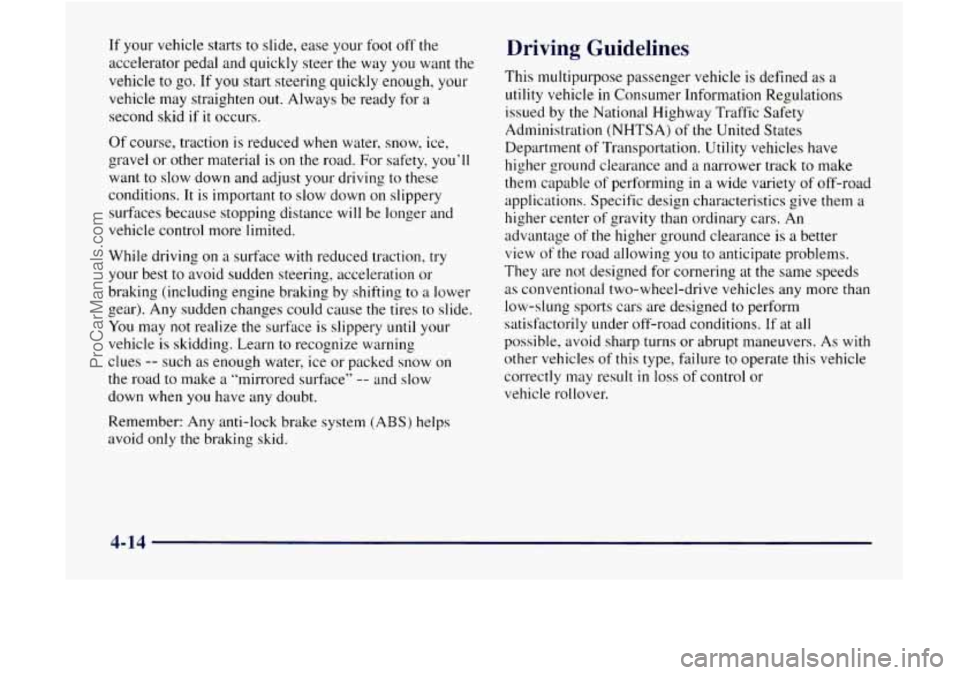
If your vehicle starts to slide, ease your foot off the
accelerator pedal and quickly steer the way you want the
vehicle to go.
If you start steering quickly enough, your
vehicle may straighten out. Always be ready for
a
second skid if it occurs.
Of course, traction is reduced when water, snow, ice,
gravel or other material is
on the road. For safety, you‘ll
want to slow down and adjust your driving to these
conditions.
It is important to slow down on slippery
surfxes because stopping distance will be longer and
vehicle control more limited.
While driving on a surfxe
with reduced traction, try
your best to avoid sudden steering, acceleration
or
braking (including engine braking by shifting to a lower
gear). Any sudden changes could cause the tires to slide.
You may not realize the surfdce is slippery
until your
vehicle is skidding. Learn to recognize warning
clues
-- such as enough water, ice or packed snow on
the road to make a “mirrored surface”
-- and slow
down when
you have any doubt.
Remember: Any anti-lock brake system (ABS) helps
avoid only
the braking skid.
Driving Gu idelines
This multipurpose passenger vehicle is defined as a
utility vehicle in Consumer Information Regulations
issued by the National Highway Traffic Safety
Administration (NHTSA) of
the United States
Department of Transportation. Utility vehicles have
higher ground clearance and a narrower track to make
them capable of performing in a wide variety of off-road
applications. Specific design characteristics give them a
higher center of gravity than ordinary cars. An
advantage of the higher ground clearance is a better
view of the road allowing you
to anticipate problems.
They are not designed for cornering at
the same speeds
as conventional two-wheel-drive vehicles any more than
low-slung sports cars are designed to perform
satisfxtorily under off-road conditions.
If at all
possible, avoid sharp turns
or abrupt maneuvers. As with
other vehicles of this type, failure to operate this vehicle
correctly
may result in loss of control or
vehicle rollover.
4-14
ProCarManuals.com
Page 177 of 386
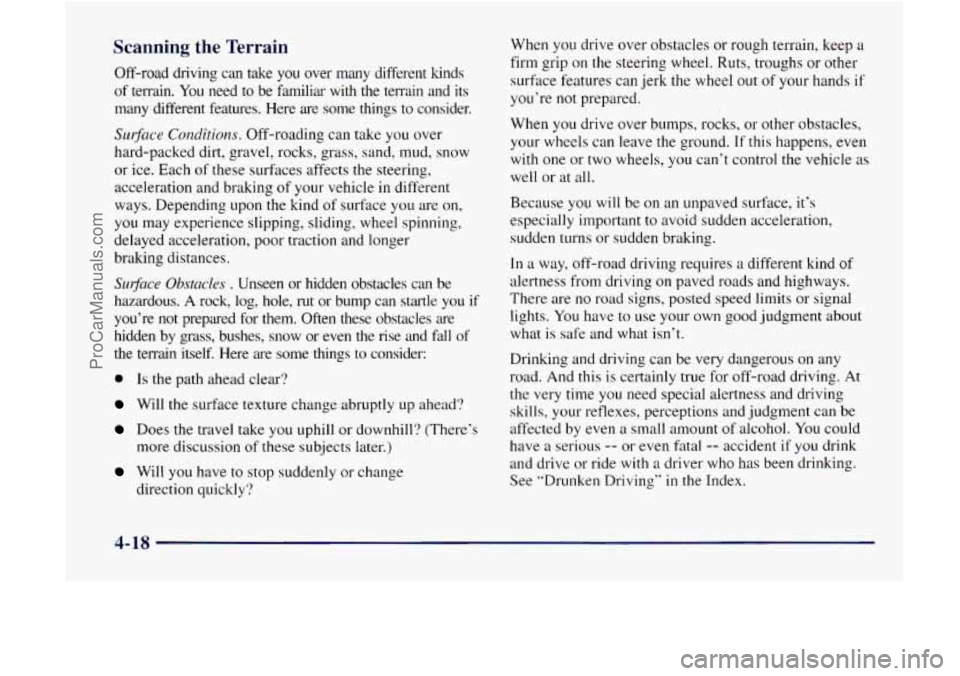
Scanning the Terrain
Off-road driving can take you over many different kinds
of terrain.
You need to be familiar with the telrain and its
many different features. Here are some things to consider.
S~lr$uce Conditions. Off-roading can take you over
hard-packed dirt, gravel, rocks, grass, sand, mud, snow
or ice. Each of these surfaces affects the steering,
acceleration and braking of your vehicle
in different
ways. Depending upon the kind of surface
you are on,
you may experience slipping, sliding, wheel spinning,
delayed acceleration, poor traction and longer
braking distances.
Su$ace Obstucles . Unseen or hidden obstacles can be
hazardous.
A rock, log, hole, rut or bump can startle you if
you're not prepared for them. Often these obstacles are
hidden by grass, bushes, snow
or even the rise and fall of
the terrain itself. Here are
some things to consider:
0 Is the path ahead clear'?
Will the surface texture change abruptly up ahead?
Does the travel take you uphill or downhill? (There's
more discussion of these subjects later.)
Will you have to stop suddenly or change
direction quickly'? When you
drive over obstacles or rough terrain, keep
a
firm grip on the steering wheel. Ruts, troughs or other
surhce features can jerk the wheel out
of your hands if
you're not prepared.
When you drive over bumps, rocks, or other obstacles,
your wheels can leave the ground.
If this happens, even
with one or two wheels, you can't control the vehicle as
well or at all.
Because you
will be on an unpaved surface, it's
especially important to avoid sudden acceleration,
sudden turns or sudden braking.
In a way, off-road driving requires a different kind of
alertness from driving on paved roads and highways.
There are no road signs, posted speed limits or signal
lights.
You have to use your own good judgment about
what is safe and what isn't.
Drinking and driving can be very dangerous
on any
road. And this is certainly true for off-road driving. At
the very time
you need special alertness and driving
skills, your reflexes, perceptions and judgment can be
affected by even
a small amount of alcohol. You could
have a serious
-- or even fatal -- accident if you drink
and drive or ride with a driver who has been drinking.
See "Drunken Driving"
in the Index.
4-18
ProCarManuals.com
Page 184 of 386

Getting out on the downhill (low) side of a vehicle
stopped across an incline is dangerous.
If the
vehicle rolls over, you could be crushed
or killed.
Always get out on the uphill (high) side of the
vehicle and stay well clear of the rollover path.
Driving in Mud, Sand, Snow or Ice
When you drive in mud, snow or sand, your wheels
won’t get good traction. You can’t accelerate
as quickly,
turning is more difficult, and you’ll need longer
braking distances.
It‘s best
to use a low gear when you’re in mud -- the
deeper
the mud, the lower the gear. In really deep mud,
the idea
is to keep your vehicle moving so you don’t
get stuck. When
you drive
on sand, you’ll sense a change in wheel
traction.
But it will depend upon how loosely packed the
sand is. On loosely packed sand (as on beaches or sand
dunes) your tires will tend
to sink into the sand. This has
an effect on steering, accelerating and braking. You may
want
to reduce the air pressure in your tires slightly
when driving on sand. This will improve traction.
Hard packed snow and ice offer the worst tire traction.
On these surfaces, it’s very easy
to lose control. On wet
ice, for example, the traction is
so poor that you will
have difficulty accelerating. And
if you do get moving,
poor steering and difficult braking can cause you to slide
out
of control.
LA CAU-ION:
Driving on frozen lakes, ponds or ~ ~ rers can be
dangerous. Underwater springs, currents under
the ice, or sudden thaws can weaken the ice. Your
vehicle could fall through the ice and you and
your passengers could drown. Drive your vehicle
on safe surfaces only.
4-25
1
ProCarManuals.com
Page 208 of 386

Passing
You’ll need more passing distance up ahead when
you’re towing a trailer. And, because you’re
a good deal
longer,
you’ll need to go much farther beyond the
passed vehicle before you can return to your lane.
Backing Up
Hold the bottom of the steering wheel with one hand.
Then,
to move the trailer to the left, just move that hand
to the left. To move the trailer to the right, move your
hand to the right. Always back up slowly and,
if
possible, have someone guide you.
Making Turns
NOTICE:
~~
Making very sharp turns while trailering could
cause the trailer to come in contact with the
vehicle. Your vehicle could be damaged. Avoid
making very sharp turns while trailering.
When you’re turning with a trailer, make wider turns than
normal.
Do this so your trailer won’t strike soft shoulders,
curbs, road signs, trees or other objects.
Avoid jerky or
sudden maneuvers. Signal well
in advance.
Turn Signals When Towing a Trailer
When you tow a trailer, your vehicle has to have extra
wiring and a heavy-duty turn signal flasher.
The arrows on your instrument panel will flash
whenever you signal a
turn or lane change. Properly
hooked up,
the trailer lamps will also flash, telling other
drivers you’re about to
turn, change lanes or stop.
When towing a trailer, the arrows
on your instrument
panel will flash for turns even
if the bulbs on the trailer
are burned out. Thus, you may think drivers behind you
are seeing your signal when
they are not. It’s important
to check occasionally
to be sure the trailer bulbs are
still working.
4-49
I
ProCarManuals.com